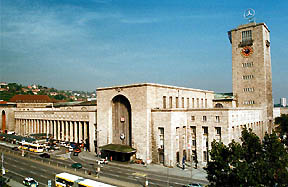Studebaker helped sell '50s Mercedes
By Ray Windecker
The Mercedes-Benz star tops the train station.
LIVONIA -- The merger with Chrysler Corp. is not Daimler-Benz AG's first dalliance with a major American automaker.
In the early-to-mid 1950s, a weak distribution system left Mercedes cars virtually invisible in the United States. Yearly sales ranged from a few units to a few hundred.
Curtis-Wright Corp., an old-line aircraft firm and early conglomerate, had business connections with both Daimler-Benz and Studebaker-Packard. In 1957, through these connections, the American distribution rights for Mercedes was acquired by Studebaker-Packard.
The automaker formed a subsidiary, Mercedes-Benz Sales Inc., headed by Lon Fleener, a veteran Packard executive. After the breakup of Studebaker-Packard, Studebaker Corp. retained Mercedes-Benz.
Although there was a core Mercedes staff, they were headquartered in Studebaker's South Bend, Ind., home office and largely borrowed from existing Studebaker and ex-Packard staff.
Dealer recruitment, sales training, and parts and service, particularly in the early years, were handled at field level primarily by existing Studebaker people, often as a sideline. I wore the multi-purpose Studebaker-Mercedes hat, signing new-dealer contracts and wholesaling vehicles for either or both organizations.
In 1959, it was often easier to dual a Big Three dealer with the Studebaker Lark/Hawk/Truck trio than it was Mercedes, even with the Mercedes franchise available at a promise to buy $10,000 in parts, tools and signs plus enough open credit to floor-plan two to four cars.
By 1964, there were more than 320 Mercedes dealers in the United States. More than 150 were Studebaker duals. Most others were dualed with other imports and domestics. Less than 20 were Mercedes exclusives.
But Studebaker was in serious trouble in 1965, having first abandoned its California plant and then its South Bend home base. It retreated to assemble cars in a small Canadian plant that could not accommodate trucks or the sporty Avanti.
The Mercedes brand was by the mid-1960s well established and selling at near 20,000 units a year, but Daimler-Benz was doing business with dealers and the public through a weak Studebaker organization. So Daimler-Benz bought back the Mercedes-Benz Sales Inc. contract for near $9 million, roughly five times the earlier selling price.
Daimler-Benz then formed Mercedes-Benz of North America Inc., ending the Studebaker-Mercedes association that spanned portions of nine years. During that time Mercedes flourished, becoming a highly visible and respected brand, while Studebaker withered, as had so many independent auto manufacturers, caught and overcome by the fierce price and share wars of the domestic Big Three.
The final Studebaker car was produced in Canada in 1966, although the Avanti continued as a low-volume independent into the 1980s.
Ray Windecker is a Livonia free-lance writer.
